WILHELM REICH: The Gayn/Straight Connection
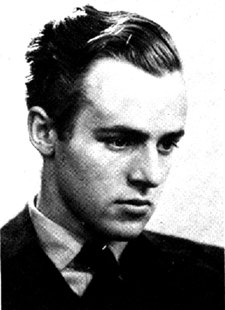
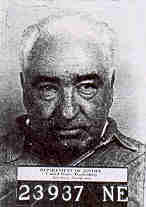
Michael Straight, in the 1930s, as a student at Cambridge, was recruited by Anthony Blunt as a mole for the Soviets. Straight gave his Soviet controller press credentials for Mark Gayn, in 1942.
(an excerpt from Flatland Magazine editor Jim Martin's forthcoming book, Am I a Spaceman? Wilhelm Reich and the Cold War.)
publication date: January 1, Y2K
this version copyright 1998 by Jim Martin [The story so far: Dr. Wilhelm Reich (1897-1957) was convinced that his trial and imprisonment had been orchestrated in Moscow. Today, conventionally received "wisdom" has been shaped by those biographers of Reich who argued that the Food and Drug Agency's prosecution of Reich had its source in the anti- sexual, xenophobic hysteria of the "McCarthy Era." In my book, tentatively titled, Am I a Spaceman? we review the historical record of the late forties and early fifties, and try to locate Wilhelm Reich's actual position in the Cold War Era. We've examined the personal biographies of those people who played a hand in initiating the public damnation of Reich, such as Mildred Edie Brady, who wrote a scurrilous attack on Reich in the leading liberal "journal of opinion" (the New Republic) and Michael Straight, the wealthy scion of a Morgan Bank partner, who published Brady's article. Long-time Steamshovellers will recall my article in issue #8 that recounted what Georgetown Professor Carroll Quigley (Bill Clinton's mentor) had to say about Straight's role in the Communist-dominated election campaign of Henry Wallace in 1947-1948, precisely at the time when Mildred Brady's article appeared in the New Republic. Toward the end of the research for that article, I came across the fact that Straight himself admitted, in an autobiography called After Long Silence, that he was in fact recruited by Soviet intelligence, back in the thirties, when he was a student at Cambridge University.
Since then, I've been able to contact Michael Straight, and interview him on several occasions. He graciously gave me personal permission to review his papers, which are under seal at Cornell University. He denies that he ever did any actual spying for the Soviets, but what he's admitted to more than confirms Wilhelm Reich's worst suspicions.
This excerpt is from a chapter that discusses the Cambridge Five Spy Ring, with which Straight was closely associated, since he had been recruited by Anthony Blunt. The American intelligence corps still does not trust the British side, not after Kim Philby - when the NSA released the highly sensitive VENONA decrypts, the Americans stood shoulder-to-shoulder with their Russian counterparts at the press conference and symposia, while the British were conspicuously absent.
I should stress here that I am not grinding a political axe, one way or another, when I point out that with the release of the archives of the former Soviet Union, and with the publication of tell-all books by some of Lyubyanka's grungiest spymasters, some of the most far-fetched anti-communist conspiracy theories of the McCarthy "hysteria" have turned out to be true. I had no idea, when I started the research on Wilhelm Reich, that I would be led into the wilderness of Cold War espionage and the theft of atomic secrets. After studying all the recent revelations, there are few secrets left from the Cold War, and it must be said that most of them are being kept by the CIA and the NSA from American citizens. I believe one of the remaining secrets, that J. Robert Oppenheimer himself was the Soviet's main source of information about the atomic bomb, will be confirmed within a year or so. Oppenheimer was recruited while at the University of California at Berkeley, where he socialized with Mildred Edie Brady.
Okay, back to the excerpt: after a discussion of Michael Straight's confessional autobiography, After Long Silence, I introduce a tangent in the research that still boggles my mind. It's got to do with a tangled web between Michael Straight, his Soviet "controller" and journalist Mark Gayn. Anyone who has read Dick Russell's marvelous The Man Who Knew Too Much may remember Mark Gayn. I hope Steamshovel Press editor Kenn Thomas won't be the only reader who will appreciate the research that links the conspiracy against Wilhelm Reich to the Kennedy assassination! Comments regarding this excerpt are welcome - send them to me at flatland@mcn.org. .........
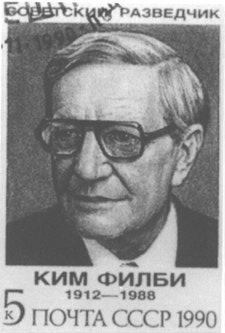
Soviet ur-mole, Kim Philby, memorialized here in a Russian postage stamp, was the most important of the "Cambridge Five" spies.
It wasn't until November 15, 1979 that Michael Straight's story reached the world, when Prime Minister Margaret Thatcher announced that Anthony Blunt was the "fourth man" of the Cambridge Soviet spy ring - after MacLean, Burgess and Philby. Even then, Straight's identity as the source who exposed both Blunt and a fifth man, Leopold Henry Long, as operatives for Soviet intelligence was not revealed to the public until 1981, when the Sunday Times ran a story which was confirmed in Parliament. Straight objected to press reports of his own spying on behalf of Russia, but decided not to pursue the matter beyond a letter to the Times, because of bad conscience.
And there ends Michael Straight's autobiographical account of his flirtations with the KGB, the CIA, and the FBI. He obliquely refers to the entire genre of literature, spy novels, counterintelligence surveys, and press accounts engendered by the revelations of the case. He succeeds in ignoring completely the implications and fall-out of the Cambridge Five's exposure of the deep penetration of the Britain's intelligence apparatus, the consequent compromise of the CIA at the highest levels, and he says nothing about the ring's role in the theft of atomic secrets.
Straight was never accused by the FBI of actively spying, and he makes every effort to make the point that the information he gave to "Michael Green," though classified, was of no strategic importance. It would appear that the most significant aid given by Straight to the Soviets was to remain silent about the covert work of Guy Burgess and Anthony Blunt, both of whom he knew to be spies. However, Straight's FBI files include reference to a meeting between Straight, "Green," and Green's wife (the niece of CPUSA leader Earl Browder) at a restaurant in New York. At Green's request, Straight provided a press credential for Mark Julius Gayn sometime in 1942. Providing press credentials to a Soviet agent is a more serious event than Straight admits to. Three years later, in June of 1945, Gayn was arrested along with six others, including two State Department officials, Lauchlin Currie and John Stewart Service, and a young Office of Naval Intelligence officer named Andrew Roth, for possession of hundreds of highly classified documents in what would become known as "The Amerasia Case," the first inkling the American public received as to the breadth of Soviet post-war espionage reaching into top levels of the government.
The overlapping territories of journalism and intelligence work can be demonstrated by a brief examination of the career of Mark Julius Gayn. Like Kim Philby, Guy Burgess, and so many others, Gayn used journalistic cover for his activities.
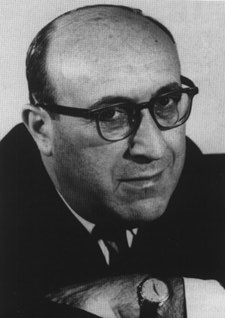
Journalist Mark Gayn was arrested in 1945 when the Office of Naval Intelligence discovered hundreds of secret government documents strewn around the offices of Amerasia Magazine. He was never prosecuted.
The Legend of Mark Gayn
Much of the information regarding Mark Julius Gayn's early life in China can be found in a disturbing book written by his brother who remained behind after the revolution of 1948. Sam was a translator and language teacher and suffered greatly during the Cultural Revolution. Born Mark Ginsbourg in Siberia, Mark Gayn and his brother, Sam were raised in Harbin, China amongst a small but prosperous community of Russian exiles, many of whom were Jewish refugees from Czarist pograms.
Sam's book never mentions his eldest brother by name, which is strange, since they were close. None of the names of family members are mentioned. Mark Gayn worked in the Red Army's library in Vladivistok, and majored in "pedagogy" at the Soviet "Institute for Teachers, Librarians and Propagandists" in 1926. (Later, Mark Gayn would tell FBI agents that this school was "similar to an American junior college.") A few years later, he went to Pomona College in Southern California. It's not at all clear how his family came up with the money to send Mark to California, but Sam says they did. Mark told the FBI that he worked his way through college. Dick Russell says Mark was back in Shanghai in 1939, and Sam confirms this. That same year, his mother and father relocated to "heavenly" Los Angeles, and Sam never saw them again. By then Mark Gayn had graduated from Columbia University and returned to China. "In the mid-thirties he returned to China and did editorial work on some English- language newspapers published in Shanghai. He was violently anti-Japanese and did not try to conceal it. He finally made the Japanese military black-list, on which he occupied a prominent place. He managed to escape, leaving Shanghai in the summer of 1939. Soon after arriving in the United States, he changed his name to make sure the Japanese did not take it out on me." [Wasn't this a bit late? Shouldn't Sam have changed his name? Didn't Mark change his name to hide his Soviet training in "propaganda"?]
"After victory, he was assigned to Japan as a war correspondent for one of the big American dailies. We exchanged letters. At the end of December 1946 he arrived in Shanghai. He stayed there for some weeks and then left for the Liberated Areas for some interviews with our Party leaders. (Recently he showed me a photograph of him and Liu Shaoqi taken in those days.) Not waiting for him to return to Shanghai, I went to the Shandong Liberated Area and left him a brief note informing him of what I had done. "My departure made him unhappy. He wished I had talked things over with him before making such an important decision, of which he did not approve. "We lost all touch with each other until the late seventies." Sam's daughter went to live with Mark Gayn while she attended a university in Canada, before returning to China.
The rest of the book describes Sam losing his post as a foreign languages teacher during the succession of upheavals in China starting with the Cultural Revolution, during which he was accused of being a "Russian spy". The brutality and humiliation during this period is clear enough, but Sam is still writing confessions with a Red Guard looking over his shoulder, so he sounds a bit like Winston Smith at the end of Orwell's 1984. He loves his country and his Party, despite its "excesses". Things are looking up. Probably, he should have talked it over with Mark first. Did Mark had an inkling of what was to come?
After graduating from Pomona, Gayn began a long career in journalism. Gayn wrote for national magazines such as Collier's and in 1934 he became the Washington Post's special correspondent in China until his return to the U.S. in 1939. Michael Straight met with his Soviet handler ("Michael Green") at Longchamps restaurant in New York sometime after November 24, 1942. In later statements to the FBI, Straight recalled that at this meeting or the one previous, Straight supplied to "Green," at his request, journalistic accreditation (i.e., journalistic "cover") for a Swedish woman journalist and Mark Julius Gayn. Why would Gayn, already a widely-published reporter, need additional accreditation from Straight? Why would "Green," rather than Gayn himself, ask Straight for these credentials? What we do know is that Mark Julius Gayn, subsequent to being accredited as a journalist for The New Republic, began to amass an impressive collection of classified documents from the U.S. Departments of State, War, and the Office of Strategic Services (OSS). Many of the documents dealt with "psychological warfare" and propaganda, and nearly all of them dealt with the Chinese theatre in the war against Japan. When a classified report from the OSS turned up - almost verbatim - in the pages of Amerasia, U.S. counter-intelligence agents broke into Amerasia's offices and began an intensive, 24-hour surveillance of everyone connected with it, including Mark Gayn. Amerasia was a small-circulation, pro-Maoist journal published by Philip Jaffee and partially funded by the Institute of Pacific Relations, which in turn was financially supported by Nelson Rockefeller, Michael Straight, and a host of "philanthropic" foundations that later became the subject of a congressional investigation called "The Reece Commission."
The FBI set up a massive, round-the-clock surveillance of the spy ring, capturing on tape, via wire-taps, conversations between Mark Gayn, Phil Jaffe, and the others. Jaffe referred to the secret documents he obtained as "cigarettes" - using an inept code; "I have some fine Japanese cigarettes," etc...
The FBI files leave no doubt that Gayn was working for the Soviets.
Jaffe: It is just as you thought. She is talking all over Washington, especially in official circles, and plastering you with the good old 'red brush."
Gayn: Me personally?
Jaffe: Yeah, you personally. Very continuous. Continuous activity on her part and you should not turn your back on her, because if you do, she will stab you.
Gayn: My turning my back or not turning my back, I have nothing to do.
Jaffe: No, nothing you can do, but run the hell out of this country and over to the Soviet Union. You will be safer there. [Uncle] Joe will protect you.
In their book The Amerasia Spy Case, Prelude to McCarthyism, historians Harvey Klehr and Ronald Radosh mark the case as one of the most important in the Cold War. Coming as it did, during the last years of WWII, it set the tone for future relations between the two post-war superpowers. The investigation uncovered a network of journalists, State Department officials, and servicemen who were caught red-handed spying for Russia. The evidence against those arrested was overwhelming. However, the charges were dropped. Gayn, who was in as deep as the rest of them, was not even indicted. Klehr and Radosh suggest that a political fix crafted by none other than Michael Straight's old boss in the Roosevelt administration, Tommy "the Cork" Corcoran, worked the deal. There is also the possibility that Gayn, in particular, was let off in return for "turning" sides and becoming a double-agent. No other journalist, on either side of the Iron Curtain, could match Mark Julius Gayn's access to the highest echelons of power in Moscow, Peking and Washington, throughout the fifties.
Autumn, 1959: Mark Gayn's notebook records an exchange between Dulles and Khrushchev: "Dulles said to Khrushchev: 'You Mr. Chairman may have seen some of my intelligence reports from time to time.' Khrushchev said 'I believe we get the same reports. And probably from the same people.' Dulles said: 'Maybe we should pool our efforts.' Khrushchev: 'Yes, we should buy our intelligence data together and save money, we'd only have to pay the people once.'"
So this is a another bizarre twist, one of many in this investigation: Michael Straight gave credentials to a journalist-spy, who was subsequently cleared in what had appeared to be an open-and-shut case. While Straight was never implicated directly in the Amerasia case, it is hard to conceive some constructive purpose Straight had in mind when he provided his Soviet handler with Gayn's press credential, three years prior to Gayn's arrest. Today, Straight no longer remembers giving "Green" the credentials.
There is one final turning point in the Cold War saga of Mark Julius Gayn.
After the U.S. Attorney General declined to file charges in the Amerasia case, Gayn resumed his work in journalism. There would be no further public scandals involving Gayn, until long after he died in 1981. In 1992, journalist Dick Russell published one of the most well-documented and intriguing books ever written about the Kennedy assassination, The Man Who Knew Too Much. Russell unfolded the story of a Korean war-hero, former military intelligence officer in Japan, Richard Case Nagell. About a month before the assassination, Nagell said, he sent a registered letter to J. Edgar Hoover at the FBI, warning him that Lee Harvey Oswald, along with two Cuban refugees, were planning to assassinate the President. The FBI denied having received this letter when it was requested by Congressman Don Edwards (D-California) in 1974.
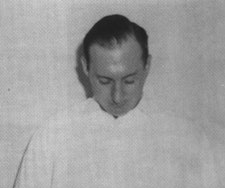
Richard Case Nagell, in a police line-up in September 1963, after his arrest in El Paso. He said he'd rather not be in Dallas.
Nagell further stated that not only could he could prove he sent that letter, but furthermore he had a number of incriminating documents, photographs of himself and Oswald, and top-secret military intelligence reports in a Swiss safe-deposit box. Nagell was a contract agent of the CIA at that time. On September 20, 1963, Nagell walked into the State National Bank in El Paso, Texas, asked a teller for one hundred dollars in American Express travelers checks, then stepped back from the window and fired two shots from a Colt .45 pistol into the bank's ceiling, put the gun back in his belt, and calmly left the bank. He got into his car and waited until the police arrived, raised his hands and said, "I guess you've got me, I surrender." When taken into custody by the FBI, Nagell would only say, "I would rather be arrested than commit murder and treason."
Nagell's arresting officer, Jim Brunden, would later recall when interview by Russell, "When the assassination happened, I didn't think of it right away, because that was a pretty hectic time [...] Then a few days later, after Lee Harvey Oswald was killed, what Nagell said came back to me. I thought, this had to be what he what he was talking about. How the hell would e have previous knowledge of it? How would he know what was coming down in Dallas?"
Nagell had hinted to Brunden about the coming assassination of John F. Kennedy during his arrest and trial. "I really don't want to be in Dallas," Nagell told him during the preliminary hearings.
To convince the FBI that this was not a crank letter, Nagell wrote it under an alias of a "known Communist agent" with whom he had been in contact in regard to the plot to assassinate Kennedy. This alias, "Joseph Kramer," was so well-known to the FBI that they could not have failed to realize that Nagell warning should be taken seriously, because if "Joseph Kramer" had advance knowledge of the conspiracy, then so did the Soviets. Indeed, the warning letter was so carefully worded that it ought to have led Hoover to the conclusion that a Soviet agent was planning to kill Kennedy, even though Nagell (and, most likely, Hoover) knew otherwise.
"Joseph Kramer" was Mark Julius Gayn.
Nagell's account and Russell's investigative substantiation of it are far too complex to go into much detail here. In broad strokes, Nagell was a lifer in the ultra-secret intelligence operations of the CIA and the Pentagon. In a game played out in Korea, Japan, China, and the Philippines, intelligence officers like Nagell tried to recruit their counterparts into becoming double-agents, while knowing all the while that their counterparts on the Communist side were trying to do just the same. As deceit covered falsehoods, as lies traded with truth, men like Nagell lost touch with reality, and know longer knew who it was, exactly, that they were working for. In despair and rootlessness, they tried to forge their own guiding lights of ethics and purpose, but after so many years of military service, they were unequipped to do so. Ideals of honor, duty, country became shattered as the operatives saw hellish tours of duty filled with torture, murder, and terrorism in service to shifting geopolitical goals crafted by craven ideologues on all sides.
Nagell had found himself in a situation where he might have been in Oswald's shoes. His contact with agents on the Soviet side, while sanctioned by U.S. Intelligence, made him vulnerable to being cut loose, adrift, or framed. His principle contact with the Soviets, Nagell testified, was Mark Gayn, with whom he shared foreknowledge of multiple plots to kill the President of the United States. Nagell implied to Russell that he had been ordered to eliminate Oswald before he could pull the trigger. Nagell said this order was delivered by a Soviet agent, perhaps Mark Gayn, or, more startlingly, Tracy B arnes, of the CIA, Michael Straight's cousin. Recall that Straight's first approach to the US government to speak of his past, he made to his cousin Tracy Barnes.
The Amerasia Case was a cause celebre for the McCarthyites, yet Gayn somehow escaped prosecution even though he had been caught red-handed. All evidence points to the fact that he was a double agent found useful to both sides... -------------------------------------------------------------------------------------------------------------------------------